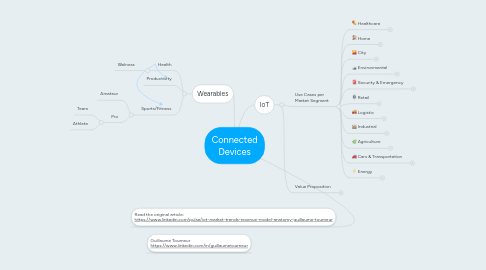
1. Wearables
1.1. Health
1.1.1. Welness
1.2. Productivity
1.3. Sports/Fitness
1.3.1. Amateur
1.3.2. Pro
1.3.2.1. Team
1.3.2.2. Athlete
2. Guillaume Tourneur https://www.linkedin.com/in/guillaumetourneur
3. Read the original article: https://www.linkedin.com/pulse/iot-market-trends-revenue-model-anatomy-guillaume-tourneur
4. IoT
4.1. Use Cases per Market Segment
4.1.1. Healthcare
4.1.1.1. Illness Monitoring & Management
4.1.1.2. Individual
4.1.1.2.1. Medication Dispensing
4.1.1.2.2. Patient Safety
4.1.1.3. Industry
4.1.1.3.1. Clinical Care monitoring
4.1.1.3.2. Remote Patient Monitoring
4.1.1.3.3. Real-time disease management
4.1.1.3.4. Real-time data exchange
4.1.1.4. Infrastructure
4.1.1.4.1. GOV/FDA compliances
4.1.1.4.2. Automated Workflow
4.1.1.4.3. Accurate Data Collection
4.1.1.4.4. Equipment monitoring and auditing
4.1.2. Home
4.1.2.1. Chore Automation
4.1.2.2. Energy Management Safety & Security Automation
4.1.2.3. Energy Management
4.1.2.3.1. Utilization Optimization
4.1.2.4. Security/Safety
4.1.2.4.1. Fire & Safety
4.1.2.4.2. Intrusion Detection
4.1.2.5. Environment control
4.1.2.5.1. Smart thermostat (e.g., Nest)
4.1.2.5.2. Air moisture
4.1.2.5.3. Smoke alarm
4.1.2.5.4. Flood detector
4.1.2.5.5. Lighting system
4.1.2.5.6. Drapes
4.1.2.5.7. Sprinkler systems (outdoor)
4.1.2.6. Smart Energy HVAC
4.1.2.6.1. Smart Meters
4.1.2.6.2. Smart Appliance
4.1.2.6.3. Smart Plug
4.1.3. City
4.1.3.1. Traffic Management
4.1.3.2. Waste Management
4.1.3.3. Public Safety & Health Traffic Control Resource Management
4.1.3.4. Public Health
4.1.3.4.1. Air Quality monitoring
4.1.3.4.2. Water Quality monitoring
4.1.3.5. Noise Urban Maps
4.1.3.6. Intelligent Transportation Systems
4.1.3.7. Surveillance
4.1.3.7.1. Public Safety
4.1.4. Environmental
4.1.4.1. Earthquake Early Detection
4.1.4.2. Forest Fire Detection
4.1.4.3. Air Quality & Pollution Detection
4.1.4.4. Avalanche & Landslide Prevention
4.1.5. Security & Emergency
4.1.5.1. Perimeter Access Control
4.1.5.2. Radiation & Liquid Detection
4.1.5.3. Explosive & Hazardous Gasses Detection
4.1.5.4. Emergency Service Management
4.1.6. Retail
4.1.6.1. Layout Optimization
4.1.6.2. Supply Chain Control
4.1.6.2.1. Monitoring Inventory Levels and assets
4.1.6.3. NFC payments
4.1.6.4. Smart Product Management
4.1.6.5. Vending Machine Remote Management
4.1.6.6. Automated Checkout
4.1.6.7. Smart CRM
4.1.6.8. In-store personalized promotions
4.1.6.9. Smart Inventory Management
4.1.7. Logistic
4.1.7.1. Quality of Shipment Condition
4.1.7.2. Item Tracking
4.1.7.3. Fleet Tracking
4.1.7.4. Logistic Routing Autonomous Naviguation
4.1.7.5. Geo-positioning
4.1.7.6. Shipment/Delivery Management
4.1.8. Industrial
4.1.8.1. HVAC
4.1.8.2. Predictive Maintenance
4.1.8.3. Warehouse Stock Location
4.1.8.4. Asset Utilization
4.1.8.5. Operations optimization
4.1.8.6. Loss Prevention
4.1.8.7. Operations Optimization Predictive Maintenance Health & Safety
4.1.8.8. Inventory Tracking
4.1.8.9. Downtime Minimization
4.1.8.10. Capacity Utilization
4.1.9. Agriculture
4.1.9.1. Fruits, Vegetables Quality Monitoring
4.1.9.2. Crop Irrigation
4.1.9.3. Green House Control
4.1.10. Cars & Transportation
4.1.10.1. Environment
4.1.10.1.1. Predictive Parking and Traffic Management
4.1.10.1.2. Converged Transportation Ecosystems & Monitoring
4.1.10.1.3. Sustainability of Infrastrcuture
4.1.10.2. Autonomous & Connected Cars
4.1.10.2.1. Vehicle-to-roadway infrastructure communication
4.1.10.2.2. Vehicle-to-vehicle communication
4.1.10.2.3. Driverless cars
4.1.10.2.4. Location Tracking
4.1.10.2.5. Real time performance monitoring of the car
4.1.10.2.6. Creating custom alerts
4.1.10.2.7. Driver assistance
4.1.10.2.8. Behavior analysis of the driver
4.1.10.2.9. Recommendation based on driving patterns
4.1.10.2.10. Maintenance
4.1.10.3. Condition-based Maintenance Accident Prevention Driverless Cars
4.1.11. Energy
4.1.11.1. Environmental
4.1.11.1.1. Solar Power Management
4.1.11.1.2. Batterie Management
4.1.11.1.3. Security
4.1.11.1.4. Power Efficiency
4.1.11.1.5. Grid Power Management & Protection
4.1.11.2. Home & Industrial Performance measurement (Electricity, Gaz, Water)
4.1.11.2.1. Historical Averages
4.1.11.2.2. Similar Installations
4.1.11.2.3. Seasonal Variances
4.1.11.2.4. Environment Pressures
4.1.11.3. Energy Management Automation Security Health Comfort
4.2. Value Proposition
4.2.1. New Sources of Revenue
4.2.1.1. New Services
4.2.1.2. Build New Ecosystems
4.2.2. More competitive
4.2.3. Demand Forecasting
4.2.4. Reduce Expenses
4.2.5. Streamline Operations
4.2.6. Improved Safety & Security
4.2.6.1. Measured Risk Reduction
4.2.7. Improved Customer...
4.2.7.1. …experience
4.2.7.1.1. Marketing
4.2.7.2. …service
4.2.7.3. …relationship
4.2.7.4. Stronger Brand
4.2.8. Streamline Regulatory Compliance
4.2.9. Real-time information

